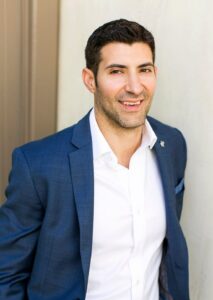An Interview With Fotis Georgiadis
The customer is not a mobile or desktop or offline customer — she is all of them. One of the biggest traps retailers fall into is believing that their consumers shop in the way their own organizational structure is set up: that is, the online marketing group focuses on online shoppers, the mobile group focuses on the app shoppers, the retail group focuses on in-store shoppers, etc. The consumer, though, does not see it that way. She looks at your name — across your store, your website and your app — and assumes that she is buying from the same company. By the same token, she expects you to understand her across all of these platforms. That is why it will be critical for retailers to develop that 360-degree, omnichannel view of the consumer. (It is also something we can help with.)
As a part of our series about the future of retail, I had the pleasure of interviewing John Kelly.
John Kelly is based out of San Francisco Bay Area and works at Zenreach as CEO.
Thank you so much for joining us! Can you tell us a story about what brought you to this specific career path?
I started off my career as an attorney in New York City during the dotcom boom. While I was stuck working 70-hour weeks in starched suits, writing memos on coal mining regulations, and reviewing lease agreements, my peers on the West Coast were wearing shorts and flip flops and carving new paths on the information superhighway. I knew I had to jump ship, so I did…just in time for the ship to sink in the subsequent dotcom bust.
Fast forward a few years, and I can say that while there has certainly been a lot of hype and exaggerated promises, the technological progress is undeniable. Between stints at Yahoo!, eBay, Criteo and a few startups, I have been witness to some fantastic developments and exciting moments. When I made the jump into the internet, I thought at the least it might provide a few good stories. On that front, it has not disappointed.
Can you share the most interesting story that happened to you since you started your career?
During my first month as an attorney, I was assigned to put together a closing table for a major debt offering. This was a really big deal. There were three law firms, four banks, 12 parties, and the Federal Trade Commission involved. We got through the signing of all 100 documents and the transfer of funds was authorized, with the wire agencies for all of the participating banks on the phone.
The transfer of the $1B was initiated by the originating bank, but it was not received by the destination bank. We waited to see if there was a delay in the bank wires, but after an hour we realized that the wires were working fine. Somehow, the banks had lost, no joke, $1B.
The crazy thing was that, because this transaction needed to close that day or there were major complications, one of the banks decided to step in and lend the money to the transaction (while they sort out where the funds had gone). It took this bank less than one hour to raise the money, one hour to raise $1B. They found the missing funds the next day in an incorrect account, and whoever owned that account woke up to a whole lot of interest income!
Can you share a story about the funniest mistake you made when you were first starting? Can you tell us what lesson or takeaway you learned from that?
One of the biggest mistakes I made was early in my career was when I was young and thought that I would impress my boss by bringing him to a big meeting with a potential partner. I had done my research on the partner and had prepared a killer presentation. It was a mapping of the partner’s strategy with ours, and I was so excited I jumped right into it. I began by recapping their strategy and how my partnership proposal would be a perfect fit with that strategy.
About halfway through the presentation, the partner stopped me and said: “You have done a good job articulating the strategy we used to have.” He then informed me that they had revamped that strategy a month earlier and had chosen a different direction.
My biggest takeaway was to never assume I knew what a client wants. It has been a reminder to me ever since of the power of simply asking questions.
Are you working on any new exciting projects now? How do you think that might help people?
Zenreach has already developed some breakthrough technology by being able to know when a user has seen an online message (an email or display advertisement) and when that user subsequently visits a physical location. We call it a “walk-through,” and it is changing the game for offline retailers. No longer do offline retailers have to buy ads hoping that the clicks or likes translate into visits. And to those retailers who are spending millions of dollars for a probabilistic study of how many people might have come into a location after seeing an ad, we can do the same for pennies on the dollar and with greater accuracy.
What we are currently working on — and it is already being beta-tested with a few of our clients — is to take this insight one step further. Now we are able to track the online/offline journey of a customer between a website and a physical store. Therefore, we are now able to tell merchants how many people visited their website and then went to one of their retail locations (and vice-versa). This is a giant step in delivering to merchants a 360-degree, omnichannel view of the customer journey.
Which tips would you recommend to your colleagues in your industry to help them to thrive and not “burn out”?
About 15 years ago, I tried my hand at some endurance sports. If you are a mere mortal and want to do a marathon or a major triathlon, you have to do two essential things: 1) plan your workouts and 2) rest. Some people are more gifted than others and can get away with fewer workouts or less planning. But no one gets away without rest. Sure, you might be able to “run” every day, but running every day can deplete muscle and stamina instead of building it.
I believe that the same applies to anything in your life that requires prolonged, sustained effort and dedication. Sure, you can “work” all the time, but are you adding value or depleting reserves when you have been up for 36 hours straight for the third time in two weeks? Plan your effort and milestones, and make sure to plan your rest.
None of us are able to achieve success without some help along the way. Is there a particular person who you are grateful towards who helped get you to where you are? Can you share a story?
There are many people who have helped me in my career. Some of the most memorable are those who took a chance on me when I was by all accounts severely underqualified for the responsibilities at hand. But the best business experience I have ever had was during my early days at Criteo, when working for the founder and CEO.
He was not the easiest person to please by nature, and he set the performance bar so high I got dizzy just looking at it. And when he set the challenge of growing revenues at an acceleration curve unheard of for a B2B product, I was convinced of my own failure as soon as I walked out of the room. But somehow, through really hard work, late nights, and a few lucky bounces, we managed to hit the elusive “hockey stick” growth curve. That experience opened my eyes to how many limitations I had been placing on myself beforehand.
How have you used your success to bring goodness to the world?
I wish I could share with you my long list of philanthropic endeavors, but the truth is if I am able to bring any goodness to this world, it is in a quite limited fashion. For the past six years, I have volunteered as a coach in youth league basketball and football. My knowledge of those sports is limited, my master of coaching techniques even more so, and my ability to relate to the latest preteen memes is nonexistent. Nonetheless, seeing the progress of the players is rewarding, and the smile on the face of the worst player on the team when he scores his first goal ranks pretty high on the good news barometer. But when I see how supportive these kids are of their teammates — especially those that are not as advanced — I am convinced I derive more goodness from them than I bring.
Ok super. Now let’s jump to the main question of our interview. Can you share 5 examples of how retail companies will be adjusting over the next five years to the new ways that consumers like to shop?
I see the following as major opportunities for retail companies in the future:
- You can stink at price or you can stink at service, but you can’t stink at both. Sure, consumers want to save money, and most of us will invest time in comparing prices for many items. But that is not the entirety of the calculus. We also want good quality, good customer service, efficient delivery, liberal return policies, etc. And consumers recognize that sometimes we have to pay more to get better service, faster delivery, or better return policies. Paying an extra $10 for an item that arrives at my doorstep tomorrow instead of in a week might be worth it, especially if tomorrow is Valentine’s Day. A particularly acute example of this is the iPhone. At launch, new iPhones are priced pretty much the same across all channels, but the number sold on Amazon vs. eBay varies dramatically. Therefore, it will be imperative that retailers define and develop their offerings. If you want to be the low price winner, that’s great, and you might be able to sacrifice on other parts of the offering. But if you want to charge a premium, you had better deliver a premium experience.
- Your unique value proposition may not be your consumers’ value proposition. It is easy to assume that customers shop at a particular retailer because of the retailer’s unique value proposition. For example, it is assumed that Nordstrom shoppers like the extra level of customer service and Walmart shoppers appreciate the everyday low prices. And while that may be true for many, it is not necessarily true for all. Shoppers have multivariate reasons why they shop for certain items at certain retailers, and these can range from the principled (“I want to support the environment”) to the personal (“this is the only brand that fits me”) to the mundane (“that store was the closest”). Understanding the motivations of the individual will become more and more important to retailers as they seek to grow wallet share. For example, as a consumer, I appreciate Nordstrom’s customer service, and I appreciate Walmart’s everyday low prices, and I buy apparel items at both. While I shop at Nordstrom for pants and shirts, I have never bought shoes there. I have, however, bought shoes at Walmart. There is a very specific reason for this. Nordstrom has never asked me why I never buy shoes, so I have never told them. And Walmart has never asked me why I never buy shirts and pants, so I have never told them. But let’s say I did tell Nordstrom or Walmart. What would they do with that information? Is there a field in their customer file that could store this data? I doubt it. But even if there were, could Nordstrom or Walmart change anything about my experience to accomodate my needs? True personalization is much more powerful and impactful than just better merchandising or targeted ads, and retailers will need to invest in understanding customers as individuals to take advantage of it.
- Most retailers will have to invest more — not less — in online advertising. Over the past 20 years, tremendous progress has been made in online marketing and advertising technologies. We can now target individuals with personalized messages, know when they have seen the ads, know when they click on the ads, and know when they make an online purchase (and, with Zenreach, an offline purchase). That is one of the reasons why online advertising during this period has gone from less than 2% of all ad spend to over 51%. And even during this Covid-impacted year, when global advertising budgets are expected to decline, online ad spend is still expected to grow. And who is buying these online ads? Your competitors. This increase in ad spend combined with low consumer switching costs, increased consumer time spent online, and the strength of a handful of large retailers collectively mean that retailers will have to work even harder over the next few years to get their message to their customers.
- The customer is not a mobile or desktop or offline customer — she is all of them. One of the biggest traps retailers fall into is believing that their consumers shop in the way their own organizational structure is set up: that is, the online marketing group focuses on online shoppers, the mobile group focuses on the app shoppers, the retail group focuses on in-store shoppers, etc. The consumer, though, does not see it that way. She looks at your name — across your store, your website and your app — and assumes that she is buying from the same company. By the same token, she expects you to understand her across all of these platforms. That is why it will be critical for retailers to develop that 360-degree, omnichannel view of the consumer. (It is also something we can help with.)
- Today’s “wow!” experience will be tomorrow’s standard. Fifteen years ago, it was just a pipedream that I could press a button on my phone and a car service would appear at my door and would drive me to the airport, where I would get out and walk to the gate without taking my wallet or phone out of my pocket. Yet Uber made this “wow!” experience possible and disrupted an entire industry. Now imagine walking into a retailer, picking out a few items and leaving without taking your phone or wallet out of your pocket. Wouldn’t that be a “wow!” experience? And wouldn’t that be disruptive to the industry? It is coming.
You are a person of great influence. If you could start a movement that would bring the most amount of good to the most amount of people, what would that be? You never know what your idea can trigger. 🙂
Love this question! I have been in Silicon Valley for 20 years, and it is a wonderful place full of bright, ambitious, creative people who continue to carry the flame of optimism and idealism. And with that idealism comes a firm belief that new technologies solve problems. While that is certainly true, there is a denial of — indeed, a blindness to — the possibility that new technologies also create new problems.
Let’s say I go to my favorite pizzeria one night, indulge in a few too many glasses of Chianti, and start engaging in antisocial behavior. I begin yelling at the servers, I throw epithets at other patrons, and I bully the cashier to give me the meal for free because, I argue, “our currency is worthless.” How long would it take until I am removed from the pizzeria?
Now, let’s say I go home and log onto an online pizza-oriented chat or social media string. I continue my tirade, casting aspersions on others and expounding on obnoxious currency theories. How long would it take until I am removed?
I assume the response is different. The very behavior we abhor in the real world is somehow condoned online.
I would like to see Silicon Valley — indeed, the internet as a whole — adopt a user standard of conduct and develop technology to support it.
How can our readers follow you on social media?
https://www.linkedin.com/in/johnkelly7/
This was very inspiring. Thank you so much for joining us!
John Kelly Of Zenreach: The Future of Retail Over The Next Five Years was originally published in Authority Magazine on Medium, where people are continuing the conversation by highlighting and responding to this story.



